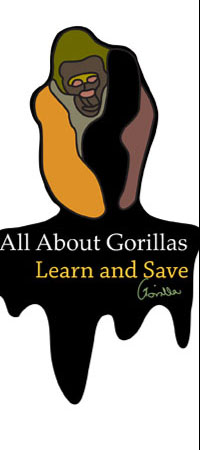|
Language
Some gorillas in captivity have been taught to communicate with humans. As part of a gorilla language project, Koko a western lowland gorilla has been taught American Sign Language and has mastered 1,000 words.
Use of tools
Younger male gorillas are called blackbacks because they have not yet developed silver hair on their back like mature males, though all males will not necessarily develop a silver back. They support the leader and help them forage. When they reach sexual maturity at the age of ten they leave their family groups to join another or form their own and find a mate. They usually travel alone or with a group of other males until they can attract a mate.
Communication
Vocal
Gorillas produce over 20 recognized sounds, each with unique meaning. Unlike humans they have large Laryngeal sacs within their vocal chamber which can be filled with up to seven litres of air, and used to increase the volume of their calls.
Visual
Gorillas, like humans use a series of facial expressions and body movements to convey messages and emotions.
Aggression
chest beating, staring with pursed lips and a tensed mouth with teeth bared.
Fear
open mouth grimace with raised eyebrows and tilted head.
Distress
pursed lips and raised eyebrows, used by infants when left alone.
Seduction
A strutting walk and bristled hair occasionally glancing at the female. This can be used as an attempt to lure females away from groups.
Olfactory
The silverback releases chemicals called pheromones from glands in his armpits, which have a strong odour. This is known as the Ďfear smellí as it can warn other gorilla of impending danger and is a signal of excitement and aggression.
Tactile
Tactile communication is very important for gorillas as it helps them to create and maintain strong social bonds. They touch each others face and hands for reassurance and groom each other regularly. Within groups lower ranking members usually groom high ranking members and adult females do not groom each other.
Reproduction and care of young
Gorillas have very slow rates of reproduction and high rates of infant mortality, as many as 40% do not survive after birth. They live in polygamous groups, meaning the dominant male mates with all the females and mating occurs when the female is mid way through her cycle. Infanticide (the killing of young) takes place on occasions when a dominant silverback dies and a new male replaces him, killing all his offspring. Mothers are very protective of their young and maintain a strong bond with them through close physical contact; the dominant silverback will also interact with young, though primary care is left to the mother.
Female gorillas in the wild become sexually mature at around 10 years old. However, males mature later and donít usually reproduce before 15 years old. Mating activity is usually initiated by the female and occurs all year round. Gestation takes approximately 8.5 months and a single infant is produced. Baby gorillas learn to crawl at around two months, can ride on their mothers backs at seven months and walk at nine months. They are breast fed for the first three years of their life, but begin to eat vegetation at around six months.
Diet
Gorillas are herbivores and therefore only eat fruit and leaves. They do not hunt or eat other animals, but occasionally feed on small insects and termites. Diet varies between species mainly due to the availability of certain foods in different habitats. Some gorilla species can consume over 200 species of plants and fruit.

|









